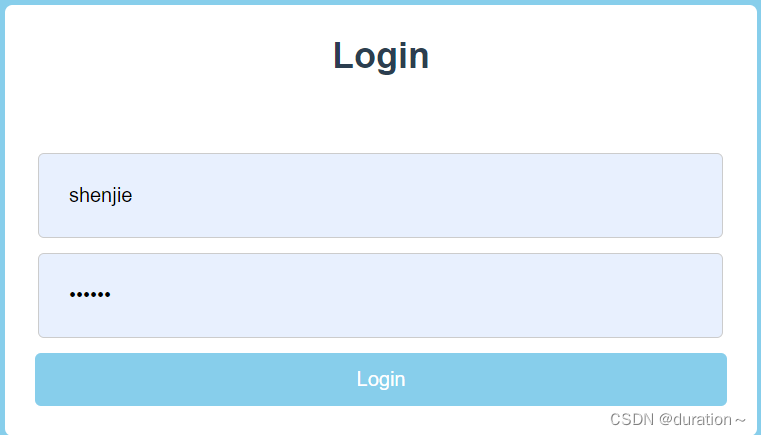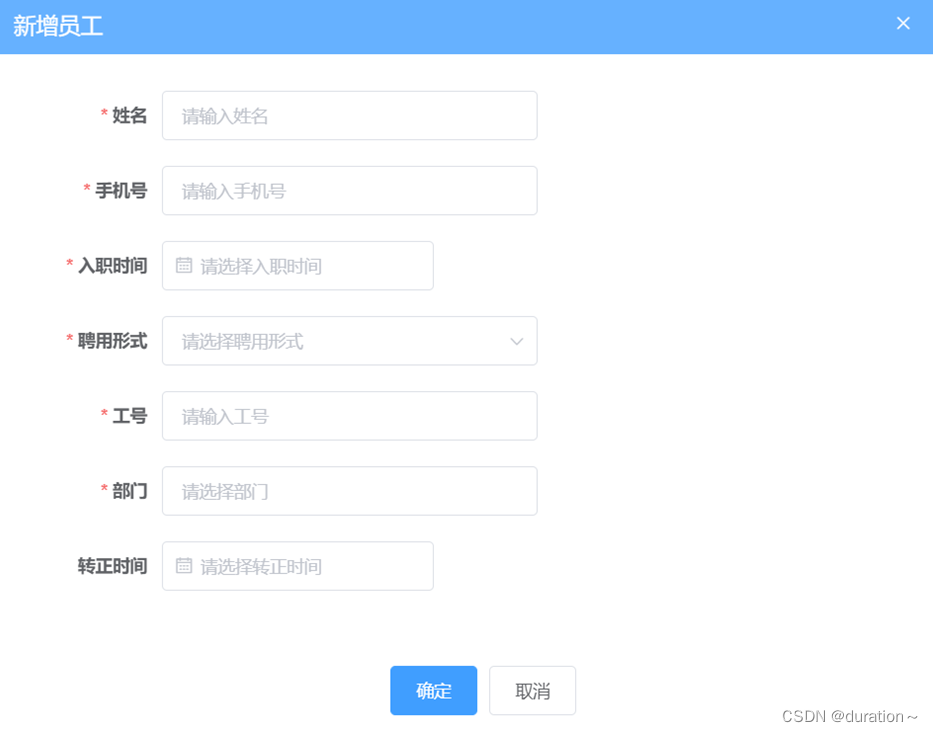快速获取全部表单元素
2023-12-27 17:17:37
form-serialize 插件
方式
使用 form-serialize 插件,快速收集目标表单范围内表单元素的值
讲解
1.我们以前收集表单元素的值,是一个个标签获取的

2.如果一套表单里有很多很多表单元素,如何一次性快速收集出来呢?

3.使用 form-serialize 插件提供的 serialize 函数就可以办到
4.form-serialize 插件语法:
-
引入 form-serialize 插件到自己网页中
-
使用 serialize 函数
-
参数1:要获取的 form 表单标签对象(要求表单元素需要有 name 属性-用来作为收集的数据中属性名)
-
参数2:配置对象
- hash:
- true - 收集出来的是一个 JS 对象结构
- false - 收集出来的是一个查询字符串格式
- empty:
- true - 收集空值
- false - 不收集空值
- hash:
-
5.需求:收集登录表单里用户名和密码
6.对应代码:
<!DOCTYPE html>
<html lang="en">
<head>
<meta charset="UTF-8">
<meta http-equiv="X-UA-Compatible" content="IE=edge">
<meta name="viewport" content="width=device-width, initial-scale=1.0">
<title>form-serialize插件使用</title>
</head>
<body>
<form action="javascript:;" class="example-form">
<input type="text" name="username">
<br>
<input type="text" name="password">
<br>
<input type="button" class="btn" value="提交">
</form>
<!--
目标:在点击提交时,使用form-serialize插件,快速收集表单元素值
1. 把插件引入到自己网页中
-->
<script src="./lib/form-serialize.js"></script>
<script>
document.querySelector('.btn').addEventListener('click', () => {
/**
* 2. 使用serialize函数,快速收集表单元素的值
* 参数1:要获取哪个表单的数据
* 表单元素设置name属性,值会作为对象的属性名
* 建议name属性的值,最好和接口文档参数名一致
* 参数2:配置对象
* hash 设置获取数据结构
* - true:JS对象(推荐)一般请求体里提交给服务器
* - false: 查询字符串
* empty 设置是否获取空值
* - true: 获取空值(推荐)数据结构和标签结构一致
* - false:不获取空值
*/
const form = document.querySelector('.example-form')
const data = serialize(form, { hash: true, empty: true })
// const data = serialize(form, { hash: false, empty: true })
// const data = serialize(form, { hash: true, empty: false })
console.log(data)
})
</script>
</body>
</html>
插件源文件form-serialize.js:
// get successful control from form and assemble into object
// http://www.w3.org/TR/html401/interact/forms.html#h-17.13.2
// types which indicate a submit action and are not successful controls
// these will be ignored
var k_r_submitter = /^(?:submit|button|image|reset|file)$/i;
// node names which could be successful controls
var k_r_success_contrls = /^(?:input|select|textarea|keygen)/i;
// Matches bracket notation.
var brackets = /(\[[^\[\]]*\])/g;
// serializes form fields
// @param form MUST be an HTMLForm element
// @param options is an optional argument to configure the serialization. Default output
// with no options specified is a url encoded string
// - hash: [true | false] Configure the output type. If true, the output will
// be a js object.
// - serializer: [function] Optional serializer function to override the default one.
// The function takes 3 arguments (result, key, value) and should return new result
// hash and url encoded str serializers are provided with this module
// - disabled: [true | false]. If true serialize disabled fields.
// - empty: [true | false]. If true serialize empty fields
function serialize(form, options) {
if (typeof options != 'object') {
options = { hash: !!options };
}
else if (options.hash === undefined) {
options.hash = true;
}
var result = (options.hash) ? {} : '';
var serializer = options.serializer || ((options.hash) ? hash_serializer : str_serialize);
var elements = form && form.elements ? form.elements : [];
//Object store each radio and set if it's empty or not
var radio_store = Object.create(null);
for (var i=0 ; i<elements.length ; ++i) {
var element = elements[i];
// ingore disabled fields
if ((!options.disabled && element.disabled) || !element.name) {
continue;
}
// ignore anyhting that is not considered a success field
if (!k_r_success_contrls.test(element.nodeName) ||
k_r_submitter.test(element.type)) {
continue;
}
var key = element.name;
var val = element.value;
// we can't just use element.value for checkboxes cause some browsers lie to us
// they say "on" for value when the box isn't checked
if ((element.type === 'checkbox' || element.type === 'radio') && !element.checked) {
val = undefined;
}
// If we want empty elements
if (options.empty) {
// for checkbox
if (element.type === 'checkbox' && !element.checked) {
val = '';
}
// for radio
if (element.type === 'radio') {
if (!radio_store[element.name] && !element.checked) {
radio_store[element.name] = false;
}
else if (element.checked) {
radio_store[element.name] = true;
}
}
// if options empty is true, continue only if its radio
if (val == undefined && element.type == 'radio') {
continue;
}
}
else {
// value-less fields are ignored unless options.empty is true
if (!val) {
continue;
}
}
// multi select boxes
if (element.type === 'select-multiple') {
val = [];
var selectOptions = element.options;
var isSelectedOptions = false;
for (var j=0 ; j<selectOptions.length ; ++j) {
var option = selectOptions[j];
var allowedEmpty = options.empty && !option.value;
var hasValue = (option.value || allowedEmpty);
if (option.selected && hasValue) {
isSelectedOptions = true;
// If using a hash serializer be sure to add the
// correct notation for an array in the multi-select
// context. Here the name attribute on the select element
// might be missing the trailing bracket pair. Both names
// "foo" and "foo[]" should be arrays.
if (options.hash && key.slice(key.length - 2) !== '[]') {
result = serializer(result, key + '[]', option.value);
}
else {
result = serializer(result, key, option.value);
}
}
}
// Serialize if no selected options and options.empty is true
if (!isSelectedOptions && options.empty) {
result = serializer(result, key, '');
}
continue;
}
result = serializer(result, key, val);
}
// Check for all empty radio buttons and serialize them with key=""
if (options.empty) {
for (var key in radio_store) {
if (!radio_store[key]) {
result = serializer(result, key, '');
}
}
}
return result;
}
function parse_keys(string) {
var keys = [];
var prefix = /^([^\[\]]*)/;
var children = new RegExp(brackets);
var match = prefix.exec(string);
if (match[1]) {
keys.push(match[1]);
}
while ((match = children.exec(string)) !== null) {
keys.push(match[1]);
}
return keys;
}
function hash_assign(result, keys, value) {
if (keys.length === 0) {
result = value;
return result;
}
var key = keys.shift();
var between = key.match(/^\[(.+?)\]$/);
if (key === '[]') {
result = result || [];
if (Array.isArray(result)) {
result.push(hash_assign(null, keys, value));
}
else {
// This might be the result of bad name attributes like "[][foo]",
// in this case the original `result` object will already be
// assigned to an object literal. Rather than coerce the object to
// an array, or cause an exception the attribute "_values" is
// assigned as an array.
result._values = result._values || [];
result._values.push(hash_assign(null, keys, value));
}
return result;
}
// Key is an attribute name and can be assigned directly.
if (!between) {
result[key] = hash_assign(result[key], keys, value);
}
else {
var string = between[1];
// +var converts the variable into a number
// better than parseInt because it doesn't truncate away trailing
// letters and actually fails if whole thing is not a number
var index = +string;
// If the characters between the brackets is not a number it is an
// attribute name and can be assigned directly.
if (isNaN(index)) {
result = result || {};
result[string] = hash_assign(result[string], keys, value);
}
else {
result = result || [];
result[index] = hash_assign(result[index], keys, value);
}
}
return result;
}
// Object/hash encoding serializer.
function hash_serializer(result, key, value) {
var matches = key.match(brackets);
// Has brackets? Use the recursive assignment function to walk the keys,
// construct any missing objects in the result tree and make the assignment
// at the end of the chain.
if (matches) {
var keys = parse_keys(key);
hash_assign(result, keys, value);
}
else {
// Non bracket notation can make assignments directly.
var existing = result[key];
// If the value has been assigned already (for instance when a radio and
// a checkbox have the same name attribute) convert the previous value
// into an array before pushing into it.
//
// NOTE: If this requirement were removed all hash creation and
// assignment could go through `hash_assign`.
if (existing) {
if (!Array.isArray(existing)) {
result[key] = [ existing ];
}
result[key].push(value);
}
else {
result[key] = value;
}
}
return result;
}
// urlform encoding serializer
function str_serialize(result, key, value) {
// encode newlines as \r\n cause the html spec says so
value = value.replace(/(\r)?\n/g, '\r\n');
value = encodeURIComponent(value);
// spaces should be '+' rather than '%20'.
value = value.replace(/%20/g, '+');
return result + (result ? '&' : '') + encodeURIComponent(key) + '=' + value;
}
文章来源:https://blog.csdn.net/m0_62943934/article/details/135239239
本文来自互联网用户投稿,该文观点仅代表作者本人,不代表本站立场。本站仅提供信息存储空间服务,不拥有所有权,不承担相关法律责任。 如若内容造成侵权/违法违规/事实不符,请联系我的编程经验分享网邮箱:veading@qq.com进行投诉反馈,一经查实,立即删除!
本文来自互联网用户投稿,该文观点仅代表作者本人,不代表本站立场。本站仅提供信息存储空间服务,不拥有所有权,不承担相关法律责任。 如若内容造成侵权/违法违规/事实不符,请联系我的编程经验分享网邮箱:veading@qq.com进行投诉反馈,一经查实,立即删除!